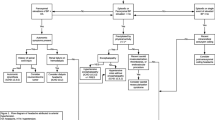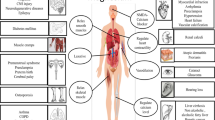Abstract
Magnesium, the second most abundant intracellular cation, is essential in many intracellular processes and appears to play an important role in migraine pathogenesis. Routine blood tests do not reflect true body magnesium stores since <2 % is in the measurable, extracellular space, 67 % is in the bone and 31 % is located intracellularly. Lack of magnesium may promote cortical spreading depression, hyperaggregation of platelets, affect serotonin receptor function, and influence synthesis and release of a variety of neurotransmitters. Migraine sufferers may develop magnesium deficiency due to genetic inability to absorb magnesium, inherited renal magnesium wasting, excretion of excessive amounts of magnesium due to stress, low nutritional intake, and several other reasons. There is strong evidence that magnesium deficiency is much more prevalent in migraine sufferers than in healthy controls. Double-blind, placebo-controlled trials have produced mixed results, most likely because both magnesium deficient and non-deficient patients were included in these trials. This is akin to giving cyanocobalamine in a blinded fashion to a group of people with peripheral neuropathy without regard to their cyanocobalamine levels. Both oral and intravenous magnesium are widely available, extremely safe, very inexpensive and for patients who are magnesium deficient can be highly effective. Considering these features of magnesium, the fact that magnesium deficiency may be present in up to half of migraine patients, and that routine blood tests are not indicative of magnesium status, empiric treatment with at least oral magnesium is warranted in all migraine sufferers.
Similar content being viewed by others
References
Abraham GE, Lubran MM (1981) Serum and red cell magnesium levels in patients with premenstrual tension. Am J Clin Nutr 34:2364–2366
Altura BT, Altura BM (1982) The role of magnesium in etiology of strokes and cerebrovasospasm. Magnesium 1:277–291
Altura BT, Altura BM (1987) Endothelium-dependent relaxation in coronary arteries requires magnesium ions. Br J Pharmacol 91:449–451
Altura BT, Altura BM (1989) Withdrawal of magnesium causes vasospasm while elevated magnesium produced relaxation of tone in cerebral arteries. Neurosci Lett 20:323–327
Altura BT, Shirley T, Young CC, Dell’Ofrano K, Handwerker SM, Altura BM (1992) A new method for the rapid determination of ionized Mg2+ in whole blood, serum and plasma. Meth Find Exp Clin Pharmacol 14(4):297–304
Baudouin-Legros M, Dard B, Guichency P (1986) Hyperreactivity of platelets from spontaneously hypertensive rats. Role of external magnesium. Hypertension 8:694–699
Bigal ME, Bordini CA, Tepper SJ, Speciali JG (2002) Intravenous magnesium sulphate in the acute treatment of migraine without aura and migraine with aura. A randomized, double-blind, placebo-controlled study. Cephalalgia 22:345–353
Cete Y, Dora B, Ertan C, Ozdemir C, Oktay C (2005) A randomized prospective placebo-controlled study of intravenous magnesium sulphate vs. metoclopramide in the management of acute migraine attacks in the emergency department. Cephalalgia 25:199–204
Coan EJ, Collingridge GL (1985) Magnesium ions block an N-methyl d-aspartate receptor-mediated component of synaptic transmission in rat hippocampus. Neurosci Lett 53:21–26
Corbo J, Esses D, Bijur PE, Iannaccone R, Gallagher EJ (2001) Randomized clinical trial of intravenous magnesium sulfate as an adjunctive medication for emergency department treatment of migraine headache. Ann Emerg Med 38:621–627
Durlach J (1976) Neurological manifestations of magnesium imbalance. In: Vinken PJ, Bruyn GW (eds) Handbook of clinical neurology, vol 28. North-Holland Publishing Co, Amsterdam
Fabricius M, Fuhr S, Bhatia R et al (2006) Cortical spreading depression and peri-infarct depolarization in acutely injured human cerebral cortex. Brain 129:778–790
Facchinetti F, Sances G, Borella P, Genazzani AR, Nappi G (1991) Magnesium prophylaxis of menstrual migraine: effects on intracellular magnesium. Headache 31:298–301
Foster AC, Fagg GE (1987) Neurobiology. Taking apart NMDA receptors. Nature 329:395–396
Goadsby PJ (2006) Migraine: emerging treatment options for preventive and acute attack therapy. Expert Opin Emerg Drugs 11:419–427
Goldstein S, Zsoter TT (1978) The effect of magnesium on the response of smooth muscle to 5-hydroxytryptamine. Br J Pharmacol 62:507–514
Hadjikhani N, Sanchez Del Rio M, Wu O et al (2001) Mechanisms of migraine aura revealed by functional MRI in human visual cortex. Proc Natl Acad Sci USA 98:4687–4692
Hoskin KL, Bulmer DCE, Goadsby PJ (1999) Fos expression in the trigeminocervical complex of the cat after stimulation of the superior sagittal sinus is reduced by l-NAME. Neurosci Lett 266:173–176
Huang QF, Gebrewold A, Zhang A et al (1994) Role of excitatory amino acids in regulation of rat pial microvasculature. Am J Physiol 266:R158–R163
Innerarity S (2000) Hypomagnesemia in acute and chronic illness. Crit Care Nurs Q 23:1–19
Jain AC, Sethi NC, Balbar PK (1985) A clinical electroencephalographic and trace element study with special reference to zinc, copper and magnesium in serum and cerebrospinal fluid (CSF) in cases of migraine. J Neurol Suppl 232:161
Mauskop A, Altura BT, Cracco RQ, Altura BM (1995a) Intravenous magnesium sulfate relieves cluster headaches in patients with low serum ionized magnesium levels. Headache 35:597–600
Mauskop A, Altura BT, Cracco RQ, Altura BM (1995b) Intravenous magnesium sulfate relieves migraine attacks in patients with low serum ionized magnesium levels: a pilot study. Clin Sci 89:633–636
Mauskop A, Altura BT, Cracco RQ, Altura BM (1996) Intravenous magnesium sulfate rapidly alleviates headaches of various types. Headache 36:154–160
Mauskop A, Altura BT, Altura BM (2002) Serum ionized magnesium levels and serum ionized calcium/ionized magnesium ratios in women with menstrual migraine. Headache 42:242–248
Mayevsky A, Doiron A, Manor T et al (2006) Cortical spreading depression recorded from the human brain using a multiparametric monitoring system. Brain Res 740:268–274
Mazzotta G, Srachielli P, Alberti A, Gallai V (1999) Intracellular Mg2+ concentration and electomyographical ischemic test in juvenile headache. Cephalalgia 19:802–809
Meller ST, Gebhart GF (1993) Nitric oxide (NO) and nociceptive processing in the spinal cord. Pain 52:127–136
Myrdal U, Leppert J, Edvinsson L et al (1994) Magnesium sulphate infusion decreases circulating calcitonin gene-related peptide (CGRP) in women with primary Raynaud’s phenomenon. Clin Physiol 14:539–546
Olesen J, Thomsen LL, Eversen H (1994) Nitric oxide is a key molecule in migraine and other vascular headaches. Trends Pharmacol Sci 15:149–153
Peikert A, Wilimzig C, Kohne-Volland R (1996) Prophylaxis of migraine with oral magnesium: results from a prospective, multi-center, placebo-controlled and double-blind randomized study. Cephalalgia 16:257–263
Peters JA, Hales TG, Lambert JJ (1988) Divalent cations modulate 5-HT3 receptor-induced currents in N1E-115 neuroblastoma cells. Eur J Pharmacol 151:491–495
Pfaffenrath V, Wessely P, Meyer C et al (1996) Magnesium in the prophylaxis of migraine-A double-blind, placebo-controlled study. Cephalalgia 16:436–440
Ramadan NM, Halvorson H, Vande-Linde A et al (1989) Low brain magnesium in migraine. Headache 29:590–593
Rozen TD (2003) Aborting a prolonged migrainous aura with intravenous prochlorperazine and magnesium sulfate. Headache 43:901–903
Schimatschek HF, Rempis R (2001) Prevalence of hypomagnesemia in an unselected German population of 16,000 individuals. Magnes Res 14:283–290
Soriani S, Arnaldi C, De Carlo L et al (1995) Serum and red blood cell magnesium levels in juvenile migraine patients. Headache 35:14–16
Strong AJ (2003) Detecting and characterizing spreading depression in the injured human brain. J Cereb Blood Flow Metab 23:748
Strong AJ, Fabricius M, Boutelle MG et al (2002) Spreading and synchronous depressions of cortical activity in acutely injured human brain. Stroke 33:2738–2743
Touitou Y, Godaud JP, Ferment O et al (1987) Prevalence of magnesium and potassium deficiencies in the elderly. Clin Chem 33:518–523
Trauninger A, Pfund Z, Koszegi T, Czopf J (2002) Oral magnesium load test in patients with migraine. Headache 42:114–119
Wang F, Van Den Eeden SK, Ackerson LM et al (2003) Oral magnesium oxide prophylaxis of frequent migraine headache in children: a randomized, double-blind, placebo-controlled trial. Headache 43:601–610
Author information
Authors and Affiliations
Corresponding author
Rights and permissions
About this article
Cite this article
Mauskop, A., Varughese, J. Why all migraine patients should be treated with magnesium. J Neural Transm 119, 575–579 (2012). https://doi.org/10.1007/s00702-012-0790-2
Received:
Accepted:
Published:
Issue Date:
DOI: https://doi.org/10.1007/s00702-012-0790-2




